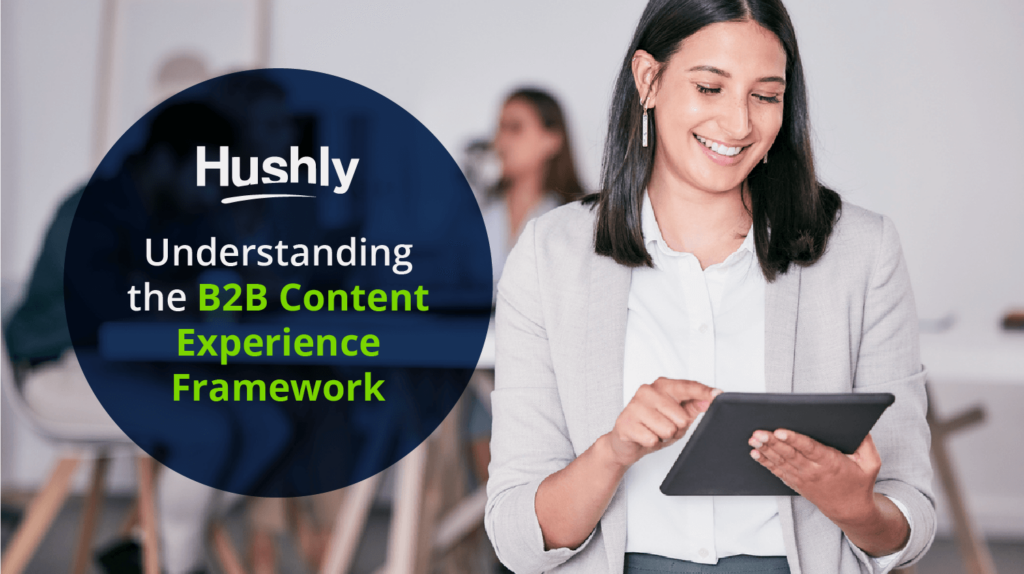Account-based marketing (ABM), and its evolution into account-based experience (ABX), has shifted the framework that informs how content should be presented to your B2B buyer audience.
There was a time when just having the information posted somewhere online was enough to add value. As marketing strategies have evolved and risen to meet the expectations of consumers, what was once enough just isn’t anymore.
Your B2B content now should meet several criteria that elevate its quality, be easier to access, and target potential buyers that you want to see more of. Optimizing your B2B content with SEO best practices is the next phase of account-based experience marketing.
To help with this shifting framework, we’ve created today’s blog that will break down the evolving B2B content experience framework and give you some ideas on how you should be implementing consumer-based content experience techniques into your B2B strategies.

Where Your B2B Content Experience Strategy Should Differ from B2C
A content experience describes not just the content that you use for marketing, but how your B2B buyers will encounter that content. The experience begins when you decide how to present the content and ends when you convert that attention into sales or information.
B2C vs. B2B Buyers
B2C buyers are individuals with highly varied tastes, opinions, and more impulsive and emotional buying habits. You can’t feasibly target every individual B2C buyer because there are just too many of them. It’s more effective in this case to advertise your product with a wide appeal: letting the largest possible number of people consider the value your product might have in their lives.
On the other hand, B2B buyers can be highly targeted and researched. Though they are unique, their needs are far more predictable. They spend more money than B2C buyers, and since the cost of transitioning between business partners is generally a hassle, they are likely to remain loyal for a long time, assuming your product quality and B2B buyer experience level stay high.
Taking Advantage of the Extra Information
The opportunity to research and gather data on the targets of a B2B ABX marketing campaign is its main advantage and difference over B2C marketing.
You can research a group of customers, but you’ll never come close to the amount of detail as if you were to spend the same amount of time researching one customer. The extra buying power and long-term relationship potential of B2B buyers can mean committing many resources to one buyer is more likely to be worth it.
Conversions Every Step of the Way
Every step of the content experience is an opportunity to convert a sale or impress a potential customer with added value and a smooth, generous marketing process. Your content experience should fit seamlessly into the ABX cycle, beginning with targeted content created specifically for certain buyer types and ending with a useful list of buyer data, leads, or a converted sale.
5 Factors of an Effective B2B Content Experience Framework
Now that you know what to aim for when designing a B2B content experience, we can list a few factors that you should consider while crafting it.
1. Quality Content Creation
Without high-quality and consistent content, none of your other efforts will matter. Content should be varied and easily available. Just as with B2C content, you’ll want to make efficient use of SEO tools so that your content creators are up to date on the latest trends.
You can use this information to craft content that appeals directly to certain buyers, which we’ll talk about more in the “personalized content” section below.
2. Consistent Updates
The challenge of crafting many high-quality articles, blogs, videos, and social media posts is massive. It can take a lot of effort and resources to keep the content churning and make sure it’s still original, educational, and entertaining.
We recommend creating a short and long-term content plan that includes the ways your content will be created, for whom, and where you plan to post that content. In the case of B2B buyers, directed blogs, email campaigns, texts, or phone calls should be consistent without being overbearing.
If your content is targeted without being too specific, it can also be modified for new buyers in the same industry, potentially minimizing your content creation burden.
3. Personalized Content
Personalized content is like a handwritten thank you note: it just shows an extra level of effort and consideration that makes a lasting impression on people. The human side of your B2B buyer will be susceptible to this kind of personalized content.
Industry trends are felt by all. Demonstrating that your company has its finger on the pulse and the presence of mind to consider the needs of your B2B buyer is a great way to increase engagement and make customers feel valued.
Focus on creating content that lets your B2B buyer see that you’ve accurately predicted a problem they are experiencing thanks to your own due diligence. Then, present how your company can solve this problem for them.
4. Targeted Distribution
Once you’ve created the content, the next step is to find the optimal way to distribute it. This will depend on several factors like who you’re distributing the content to and for what purpose.
A personal phone call to a B2B buyer might be best to talk about a new product launch or sale. Upcoming events or updates can be posted to your client’s microsite. A simple system update, on the other hand, could be handled with a personalized email to your client’s IT manager.
The way you choose to communicate the information is important, but not as important as the information itself. Still, considering the importance of the message you’re delivering will tell you a lot about how it should be delivered.
5. Keeping Track of Your Results
The final benefit of the ABX cycle is that it feeds into itself.
Regardless of how effective your initial attempts at targeted B2B content marketing are, gathering as much information about the process as possible will make your next attempt easier and more successful.
Keep track of all the data you can, including sales and marketing metrics, customer service scores, and direct client feedback. Then, update your strategy and try again. You can repeat this process forever, making improvements with every new iteration on the path towards an excellent B2B content experience.
Hushly Can Help You Build a Great B2B Content Experience
Now that you know what to look for in a great B2B content experience, we hope you’ll be able to get started optimizing your ABX strategies.
However, if this guide didn’t answer your questions or you are still unsure if a targeted B2B buyer experience is necessary for you, our platform and experts may be able to help.
No matter where you are on the content experience journey, the Hushly platform has tools and solutions to help your business reach its goals.
From targeted emails, blogs, and microsites to a smooth and enjoyable buyer portal, we’re ready to take the stress of creating a targeted B2B content experience off your hands.
Optimize your B2B content experience today. Try our personalized demo.

